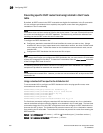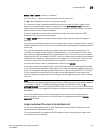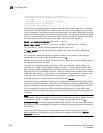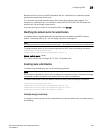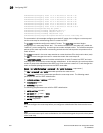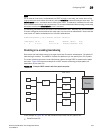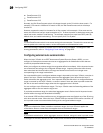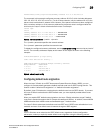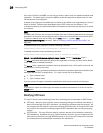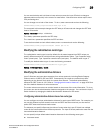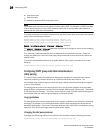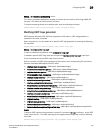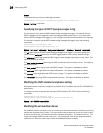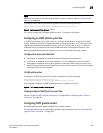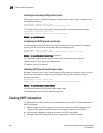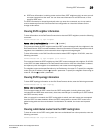
958 PowerConnect B-Series FCX Configuration Guide
53-1002266-01
Configuring OSPF
29
If the Layer 3 Switch is an ASBR, you can use the “always” option when you enable the default route
origination. The always option causes the ASBR to create and advertise a default route if it does
not already have one configured.
If default route origination is enabled and you disable it, the default route originated by the Layer 3
Switch is flushed. Default routes generated by other OSPF routers are not affected. If you
re-enable the feature, the feature takes effect immediately and thus does not require you to reload
the software.
NOTE
The ABR (Layer 3 Switch) will not inject the default route into an NSSA by default and the command
described in this section will not cause the Layer 3 Switch to inject the default route into the NSSA.
To inject the default route into an NSSA, use the area <num> | <ip-addr> nssa
default-information-originate command. Refer to “Assigning a Not-So-Stubby Area (NSSA)” on
page 935.
To enable default route origination, enter the following command.
PowerConnect(config-ospf-router)#default-information-originate
To disable the feature, enter the following command.
PowerConnect(config-ospf-router)#no default-information-originate
Syntax: [no] default-information-originate [always] [metric <value>] [metric-type <type>]
The always parameter advertises the default route regardless of whether the router has a default
route. This option is disabled by default.
The metric <value> parameter specifies a metric for the default route. If this option is not used, the
default metric is used for the route.
The metric-type <type> parameter specifies the external link type associated with the default route
advertised into the OSPF routing domain. The <type> can be one of the following:
• 1 – Type 1 external route
• 2 – Type 2 external route
If you do not use this option, the default redistribution metric type is used for the route type.
NOTE
If you specify a metric and metric type, the values you specify are used even if you do not use the
always option.
Modifying SPF timers
The Layer 3 Switch uses the following timers when calculating the shortest path for OSPF routes:
• SPF delay – When the Layer 3 Switch receives a topology change, the software waits before it
starts a Shortest Path First (SPF) calculation. By default, the software waits five seconds. You
can configure the SPF delay to a value from 0 through 65535 seconds. If you set the SPF delay
to 0 seconds, the software immediately begins the SPF calculation after receiving a topology
change.
• SPF hold time – The Layer 3 Switch waits for a specific amount of time between consecutive
SPF calculations. By default, the Layer 3 Switch waits ten seconds. You can configure the SPF
hold time to a value from 0 through 65535 seconds. If you set the SPF hold time to 0 seconds,
the software does not wait between consecutive SPF calculations.



